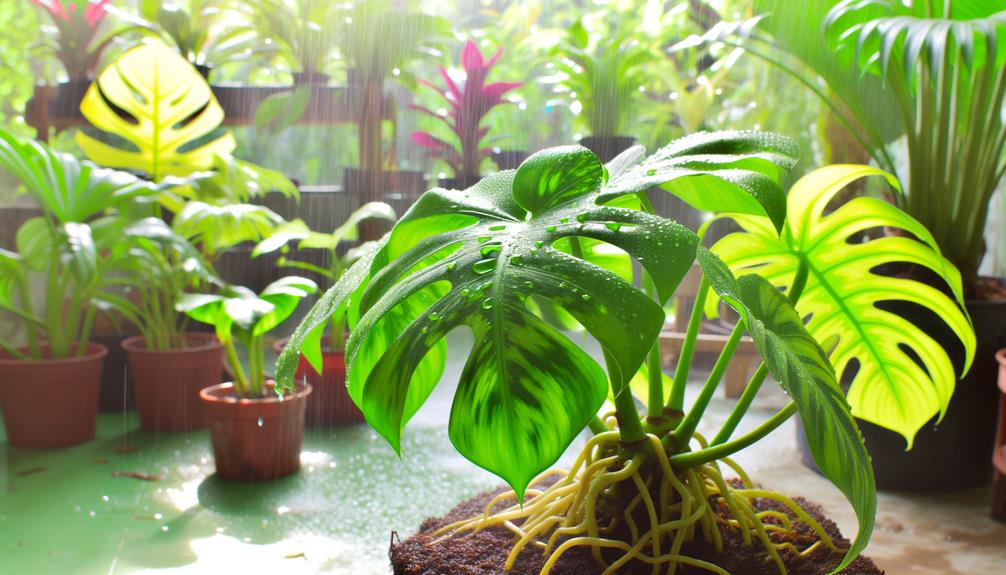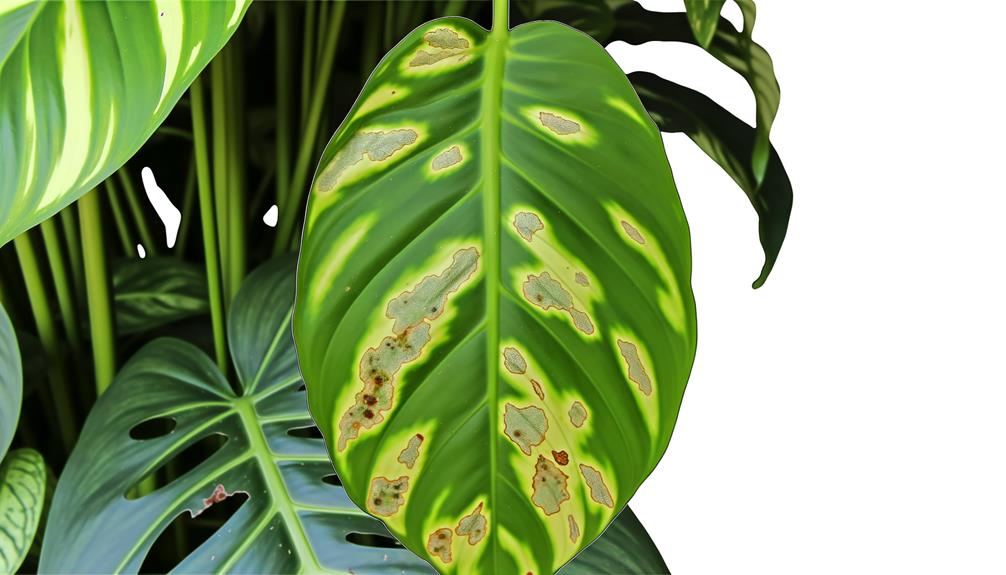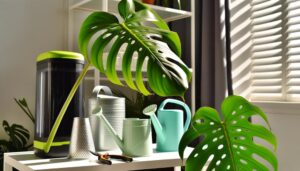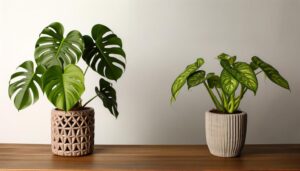Monstera Acacoyaguensis Variegated
The Monstera Acacoyaguensis Variegated, from Central and South American rainforests, showcases striking white and green variegation due to a chlorophyll mutation. This climbing plant requires bright, indirect light and consistent moisture without waterlogging.
Keep temperatures between 65-80°F and humidity around 60-70%. Fertilize bi-monthly with a 20-20-20 balance at half strength.
Watch for pests like spider mites or aphids, and prevent root rot with well-draining soil. To propagate, cut below a node and verify proper moisture and root development.
Discover how to maintain its health and beauty.

Key Takeaways
- Monstera Acacoyaguensis Variegated originates from the rainforests of Central and South America.
- It features distinctive variegated leaves with creamy whites and deep greens.
- Ideal growing conditions include bright, indirect sunlight and 60-70% humidity.
- Water when the top inch of soil is dry and fertilize every 4-6 weeks in the growing season.
- Regularly inspect for common pests like spider mites and ensure well-draining soil to prevent root rot.
Origins and History

Monstera acacoyaguensis variegated, a rare and visually striking plant, originates from the tropical rainforests of Central and South America. You'll find it primarily in countries like Mexico, Guatemala, and Honduras. These regions provide the humid, warm climate that's ideal for its growth.
The plant was first documented by botanists exploring these lush ecosystems in the mid-20th century. It flourished under the dense canopy, thriving on the forest floor where it could climb trees using its aerial roots. This Monstera variety has adapted to low light conditions, which is typical in its native habitat.
Its variegation, a genetic mutation, makes it highly sought after among plant enthusiasts and collectors. Understanding its origins helps in replicating its natural environment for best growth.
Identifying Features
In identifying Monstera Acacoyaguensis Variegated, you'll notice its distinctive leaf color patterns featuring irregular white and green variegation.
The growth habit is characterized by robust aerial roots and a climbing nature, requiring structural support.
This variegation pattern results from a genetic mutation affecting chlorophyll distribution.
Leaf Color Patterns
With their striking variegation, the leaves of Monstera acacoyaguensis exhibit a range of color patterns, from creamy whites to deep greens, which serve as key identifying features.
You'll notice the variegation manifests in irregular patches, streaks, or marbling across the lamina. The chlorophyll-deficient sections appear creamy white or yellow, contrasting sharply with the rich, chlorophyll-dense green areas.
Sometimes, the variegation may present as sectorial, where large sections of the leaf are either entirely white or green, or as marbled variegation with intermingled colors. This pattern diversity, influenced by genetic mutations affecting chlorophyll distribution, enhances the plant's ornamental value.
When examining leaf color patterns, pay attention to the consistency and distribution of variegation for accurate identification.
Growth Habit Insights
You'll notice this plant's growth habit features a climbing nature, facilitated by aerial roots that allow it to anchor onto surfaces and ascend towards light sources. The Monstera Acacoyaguensis Variegated typically exhibits fast vertical growth. Its aerial roots not only provide support but also absorb moisture and nutrients from the atmosphere. The plant's stems are robust, making it well-suited for both indoor and outdoor environments.
| Feature | Description | Function |
|---|---|---|
| Aerial Roots | Thick, fibrous, and numerous | Anchoring and nutrient absorption |
| Stem Structure | Sturdy and elongated | Supports vertical growth |
| Leaf Orientation | Alternating and spreading outward | Maximizes light capture and photosynthesis |
Understanding these characteristics helps in providing ideal care and ensuring healthy growth.
Ideal Growing Conditions

To maximize growth for your Monstera Acacoyaguensis Variegated, you need to focus on its light requirements, watering schedule, and temperature needs.
Provide bright, indirect sunlight to prevent leaf scorching while promoting variegation.
Maintain consistent soil moisture, but avoid waterlogging, and keep temperatures between 65-80°F (18-27°C) for ideal growth conditions.
Light Requirements
Monstera Acacoyaguensis Variegated thrives in bright, indirect light, mimicking its natural habitat under the forest canopy where it receives filtered sunlight. You should position your plant near east or north-facing windows to maximize it gets sufficient light without direct exposure, which can scorch its leaves. Aim for around 10,000 to 20,000 lux of light intensity.
Avoid prolonged exposure to direct sun, as this can cause leaf burn and diminish the variegation. If natural light is insufficient, consider using full-spectrum grow lights. Remember, variegated plants require more light than their non-variegated counterparts due to their reduced chlorophyll levels.
Watering Schedule
Proper watering is essential for maintaining the health and variegation of your Monstera Acacoyaguensis Variegated, as both overwatering and underwatering can lead to detrimental effects. Aim to water when the top 2-3 inches of soil are dry to the touch.
Use a well-draining soil mix to prevent root rot, ensuring the pot has drainage holes. Water thoroughly until excess drains out, avoiding waterlogged conditions.
Monitor humidity levels; this species thrives in 60-70% relative humidity. During the growing season (spring and summer), increase watering frequency. Conversely, reduce it in fall and winter when growth slows.
Adjust based on environmental conditions, observing plant response to maintain the best hydration.
Temperature Needs
In addition to maintaining proper hydration, securing ideal temperature conditions is essential for the thriving growth of your Monstera Acacoyaguensis Variegated. Aim to keep the ambient temperature within the range of 18-27°C (64-81°F).
Temperatures below 15°C (59°F) can stress the plant, leading to slowed growth and potential cellular damage. Conversely, temperatures above 30°C (86°F) may cause transpiration rates to increase, risking dehydration.
Maintain consistent temperatures, avoiding sudden fluctuations, as these can disrupt the plant's metabolic processes. If you're using artificial heating or cooling, ensure the environment remains stable.
Additionally, avoid placing your Monstera near drafts or direct heat sources, as these can create unfavorable microclimates. By monitoring and adjusting the temperature, you'll support your plant's overall health.
Watering and Feeding
For best growth, make sure you water your Monstera Acacoyaguensis Variegated when the top inch of soil feels dry to the touch, maintaining consistent soil moisture without allowing the roots to sit in waterlogged conditions. Employ a well-draining soil mix rich in organic matter to facilitate ideal aeration and moisture retention.
During the growing season, from spring to early autumn, apply a balanced liquid fertilizer every 4-6 weeks to support robust foliage and variegation. Use a fertilizer with an N-P-K ratio of 20-20-20, diluted to half the recommended strength to prevent nutrient burn. Reduce feeding during the winter months when the plant's growth rate naturally declines.
Regularly monitor soil pH, aiming for a slightly acidic to neutral range of 5.5-7.
Common Pests and Diseases

You should regularly inspect your Monstera Acacoyaguensis Variegated for common pests like spider mites, aphids, and mealybugs, as well as diseases such as root rot and leaf spot, to guarantee early detection and effective management.
Spider mites create fine webbing on leaves, while aphids and mealybugs appear as small, sap-sucking insects. Use a magnifying glass to identify these pests.
Root rot, often caused by overwatering, results in blackened, mushy roots, and yellowing leaves. Leaf spot manifests as irregular, discolored patches on foliage.
Utilize neem oil or insecticidal soap for pest control, and make sure well-draining soil to prevent root rot. Remove affected leaves and improve air circulation to combat leaf spot.
Regular monitoring is essential for a healthy Monstera.
Propagation Techniques
To successfully propagate your Monstera Acacoyaguensis Variegated, use stem cuttings with at least one node and an aerial root for best growth. Begin by sterilizing your cutting tools. Make a clean cut below a node and make sure the aerial root is intact. Place the cutting in water or a well-draining soil mix. Maintain high humidity and indirect light to encourage root development. Monitor for new root growth, which typically takes a few weeks. Shift the rooted cutting to soil once roots are established.
| Step | Description | Tips |
|---|---|---|
| 1. Cutting | Use sterilized tools to cut below a node | Confirm aerial root is present |
| 2. Medium | Place in water or well-draining soil mix | Change water frequently if in water |
| 3. Environment | Maintain high humidity, indirect light | Use a humidity dome if necessary |
| 4. Monitoring | Check for root development over several weeks | Look for white, healthy roots |
| 5. Transition | Move to soil once roots are established | Gradually acclimate to soil conditions |
Conclusion
In cultivating a Monstera acacoyaguensis variegated, you'll discover a botanical marvel that's the crown jewel of your plant collection.
By providing ideal growing conditions, attentive watering and feeding, and vigilant pest control, this plant will flourish beyond your wildest horticultural dreams.
Remember, propagation can be your secret weapon for expanding your green empire.
With precise care, your Monstera will transform your space into an unparalleled tropical paradise, a feat almost mythical in the world of indoor gardening.






